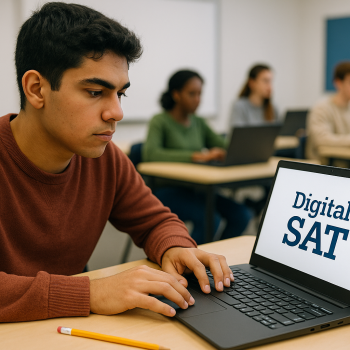Superscores, Common App, and You: Why This Matters
If you or your student are deep in the college application process, the word “superscore” pops up quickly — and understandably so. It feels a little technical, a touch mysterious, and might even change how you approach testing. This post demystifies what superscoring is, how the Common App expects you to report scores, and the best strategies to present your strongest SAT performance to colleges.

Quick preview: the short answer
Superscoring is when a college takes the highest Evidence-Based Reading & Writing (ERW) and Math section scores from multiple SAT test dates and combines them into a new, higher composite score. Whether and how you should report a superscore depends on the colleges you’re applying to and how they evaluate scores. The Common App allows you to report multiple SAT scores; you can show all test dates and also indicate the highest section-level results if you choose to self-report a superscore. But the critical point: every college has its own policy about whether it will accept or calculate a superscore, and some will request official score reports directly from College Board instead of relying on what you put in the Common App.
Understanding Superscore: What it Really Means
Let’s start with the basics, with a short example so the idea clicks.
- Test Date 1: ERW 620, Math 640 → Composite 1260
- Test Date 2: ERW 660, Math 610 → Composite 1270
- Superscore: ERW 660 (best ERW) + Math 640 (best Math) → Composite 1300
That combined 1300 is the superscore—higher than either single test’s composite. Many colleges accept superscores because it arguably shows a student’s best performance in each domain.
Why colleges use superscoring
Admissions teams like superscoring for several reasons:
- It spotlights strengths across separate testing instances rather than penalizing students for off-days.
- It can reveal preparation growth over time, which can be meaningful if a student improved study habits or received tutoring.
- It simplifies comparisons: rather than parsing multiple separate scores, a single superscore can make review quicker.
What the Common App Lets You Do
The Common App gives you a place to self-report SAT scores and multiple test dates. It doesn’t calculate a superscore for you; that’s a school-by-school decision. When filling out the testing section, you can list all your SAT dates and scores—this transparency helps colleges that want to compute their own evaluations.
Two main reporting approaches on Common App
- Full transparency: report every SAT date and score you took. This is honest and makes it easy for colleges to see your testing history.
- Targeted highlighting: report the score you want colleges to focus on (for schools that allow self-reported or single-score submission). Use this approach only when it aligns with a college’s instructions.
Step-by-step: How to Handle Superscores on the Common App
Think of this like a checklist to walk through calmly and confidently.
1. Research each college’s policy first
Not all colleges treat superscores the same way. Some will explicitly superscore when they receive multiple official score reports; others will only consider the highest single test date; some have a “test-optional” or “test-flexible” policy that changes how scores are used. Make a simple spreadsheet to track each college’s stance.
2. Self-report all test dates on the Common App
Accuracy and transparency are critical. Enter every SAT test date and score you have. If a college requires official scores later, they’ll request them from College Board — and any discrepancy can raise unnecessary flags.
3. Where allowed, show your superscore strategically
If a college explicitly says it accepts superscores and allows or prefers self-reported superscores, present your superscore as your highest, combined section scores. If a college does not superscore, make sure you still include all individual test dates so their admissions office can evaluate accordingly.
4. Send official score reports only when needed
Many colleges will request official reports from College Board only after you’ve submitted your application or when you matriculate. Know which schools require official reports at application time. If they do ask, send the official reports for all test dates the school wants to see — especially if you want them to superscore independently.
5. Use your application narrative and optional essays
If your test-scores show rapid improvement or you had extenuating circumstances (e.g., illness on a test day), briefly explain this in the optional information section or counselor recommendation. A short, factual sentence or two can contextualize a range of scores and help admissions officers understand your story.
Practical Strategies and Examples
Here are concrete approaches depending on realistic student scenarios.
Scenario A: A steady improver
Student: Took three SATs, scores improved each time. Best ERW on the second, best Math on the third.
- Action: Report all dates. If the school superscores, they’ll likely combine sections to reflect growth. If a college is test-optional, still include your best superscore if it strengthens your academic profile.
- Tip: Consider a brief note about dedicated study and one-on-one tutoring (if applicable). For example, “Improved math score after focused tutoring in spring semester.” This shows intent and effort.
Scenario B: One excellent test, two imperfect ones
Student: One very strong SAT and two lower scores due to sick days or family issues.
- Action: Report all scores on Common App. If the college superscores, the strong sections from your excellent test will count. If they do not superscore, rely on the single best date and consider explaining the context in the optional section if relevant.
- Tip: Use counselor or teacher recommendations to reinforce academic resilience where appropriate.
Scenario C: Test-optional or test-flexible schools
Student: Applying to some schools that don’t require scores.
- Action: Choose whether to submit scores based on how they fit your full application. If test scores are stronger than other quantitative indicators (like a weak AP score), submit the superscore. If your academic record and extracurriculars tell a stronger story, you might skip submitting.
- Tip: For test-optional schools, a superscore can still be a positive differentiator — but only if it strengthens your narrative.
Table: Quick Decision Guide
| College Policy | How to Report on Common App | When to Explain in Application |
|---|---|---|
| Explicitly superscores | Report all dates; optionally show your superscore where allowed | If scores vary widely, add short context in optional info |
| Uses highest single test date | Report all dates; highlight your best single-date composite | Explain only if extenuating circumstances affected lower dates |
| Test-optional/test-flexible | Decide whether scores strengthen your profile; submit only if helpful | Yes, if skipping scores could raise questions or if a poor score conflicts with GPA |
| Requires official reports at application | Send official reports for all dates requested; colleges will superscore if their policy permits | Always—clarify any score anomalies in the additional info box |
How Admissions Officers Think (and What That Means for You)
Admissions officers receive thousands of applications and need efficient ways to compare students. Superscoring, when available, simplifies part of that process by presenting a student’s best capabilities across sections. But remember: test scores are only one slice of the whole application pie. High school GPA, rigor of curriculum, essays, recommendations, and extracurricular impact often carry equal or greater weight.
What matters most
- Honesty: Always report accurately. If a college asks for official reports, send them.
- Context: A short, factual context for wide score swings helps — not excuses.
- Strategy: Where colleges superscore, leaning on your superscore is usually smart; where they don’t, highlight the single test date that best reflects you.
How to Build a Superscore-Friendly Testing Plan
If you’re still taking SATs or planning to, consider a strategy that intentionally positions you to benefit from superscoring.
1. Space tests to allow targeted improvement
Rather than back-to-back tests with minimal study windows, plan time for focused review of one section at a time. If your ERW is strong, spend practice emphasis on Math or vice versa.
2. Use mock testing and sectional practice
Practice full timed sections and full tests. Track section-level progress. Superscoring rewards the highest section scores — so aim to make each section independently strong.
3. Consider personalized tutoring
One-on-one guidance can accelerate progress. Personalized tutoring (for example, Sparkl’s personalized tutoring) often focuses on targeted skills, tailored study plans, and expert tutors who help students turn weaknesses into strengths. If you’re short on time, tutoring that zeroes in on section-specific gaps can yield the exact kind of sectional gains that make a superscore pop.
4. Practice official test conditions
Realistic practice tests help with pacing, stress management, and stamina—factors that cause uneven scores between dates. The fewer surprises on test day, the more reliable your sections will be.
How and When to Explain Score Anomalies
Occasionally, something happens—a family emergency, illness, or other disruption—that produces one unusually low test score. You don’t need to write a long essay about it, but a brief, factual note in the additional information section of the Common App can be helpful. Keep it concise and professional:
- State the fact (what happened),
- Note when it happened (test date), and
- If relevant, mention the steps you took afterward to improve (e.g., targeted study or tutoring).
Admissions officers read many applications; a clear, calm explanation helps them see the whole student behind the scores.
Practical Checklist Before Submitting Scores
- Have you listed every SAT date on the Common App? Yes → good. No → update before submission.
- Have you checked each college’s superscore policy and official reporting requirements? If not, create that college-by-college spreadsheet now.
- If you used tutors, test prep programs, or made significant improvement, have you considered briefly noting that in the additional info?
- Are you ready to send official College Board score reports for any college that requires them? Confirm your College Board account details and fee waivers if eligible.
How Parents Can Support Without Micromanaging
Parents play a huge role in the college application journey. The best support is practical, steady, and encouraging:
- Help organize the college-by-college superscore spreadsheet.
- Provide a quiet, comfortable testing space for practice tests at home.
- Encourage balanced prep—sleep, nutrition, and realistic practice schedules matter.
- Consider investing in targeted help if needed, such as 1-on-1 tutoring that focuses on specific sections and builds confidence.
When to step back
Let students take ownership of score reporting and application decisions. Your role as a supportive guide helps them develop independence and confidence before college.
Sample Email Text: When a College Requests Clarification About Scores
If an admissions officer or counselor asks for more information about your scores, here’s a short, respectful template you can use or adapt:
“Dear [Admissions Officer],
Thank you for reviewing my application. I wanted to share brief context about my SAT score on [date]. I experienced [concise factual reason—e.g., illness], which affected that test. Afterward, I focused on [specific steps—e.g., targeted math tutoring and timed practice], and my subsequent score improved. I’ve reported all test dates on the Common App and submitted my official score reports. Please let me know if you need any additional information. Sincerely, [Student Name]”
Final Thoughts: Be Strategic, Honest, and Calm
Superscoring gives many students a fairer snapshot of their academic strengths. But it’s one piece of a broader, richer admissions picture. Take a methodical approach: research each college’s policy, report honestly, and use your application materials to tell the full story. If you or your student would benefit from personalized help—targeted practice for specific sections, a tailored study plan, or one-on-one guidance to boost confidence—consider professional tutoring options that emphasize individualized plans and measurable progress. Programs that combine expert tutors with AI-driven insights can help you identify the exact skills to focus on and track improvement efficiently.
A last reassuring note to students and parents
This process is complex, but you don’t have to navigate it alone. A clear plan, accurate reporting, and thoughtful context will put your best foot forward. And remember: whether a college superscores or not, admissions officers want to meet the whole student—grades, curiosity, voice, and resilience matter as much as any test number.

Quick Resources to Build Your Plan
To wrap up: create a simple action plan for the next 2–3 months:
- Week 1: Make a college policy spreadsheet (superscore? official score required? test-optional?).
- Week 2–6: Take two timed practice tests, focus on section weak spots, and build a sectional improvement plan.
- Week 7: Decide whether to retake the SAT based on realistic improvement and college deadlines.
- Ongoing: Keep your Common App testing fields up to date and prepare brief contextual notes if needed.
Need help getting there?
If you want guided, personalized help, consider tutoring that offers tailored study plans and expert feedback—whether it’s a last-mile push to improve a Math section or a strategic plan to capture the best superscore. One-on-one coaching can be especially valuable when time is short and precision matters. Thoughtful, targeted help can transform a scatter of scores into a single, compelling academic snapshot.
Final takeaways
- Report every SAT date on the Common App—accuracy matters.
- Know each college’s policy on superscoring and official reports.
- Use optional application sections judiciously to explain major anomalies.
- Consider focused tutoring and personalized study plans if you want to improve specific sections quickly.
- Stay calm. Your application is more than a number, and colleges look for the whole person.
Good luck—this is a marathon, not a sprint. With a clear plan and the right support, you’ll present your strongest possible application. If you’d like, I can help you create that college-by-college superscore spreadsheet or draft a short optional-info statement tailored to your situation.















No Comments
Leave a comment Cancel